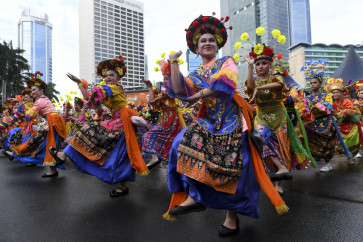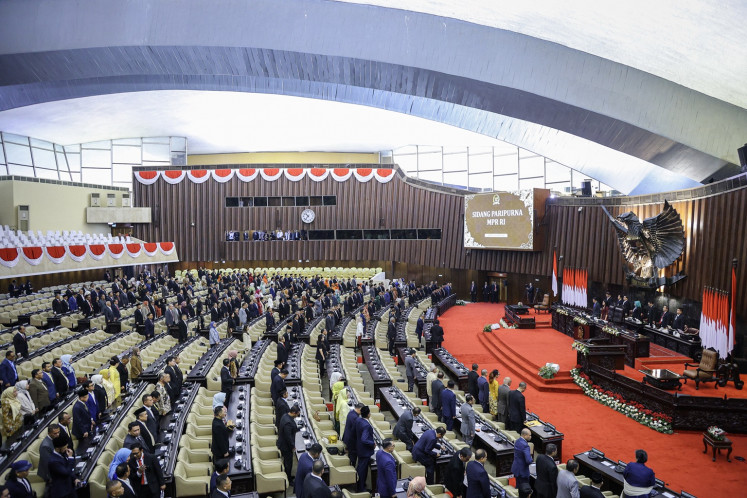Popular Reads
Top Results
Can't find what you're looking for?
View all search resultsPopular Reads
Top Results
Can't find what you're looking for?
View all search resultsSoegito Hardjodikoro: An educational officer with a big part to play
JP/Duncan GrahamSoegito Hardjodikoro isn’t a pinstripe diplomat unprepared to comment on the weather without getting an official clearance
Change text size
Gift Premium Articles
to Anyone
J
span class="caption" style="width: 398px;">JP/Duncan GrahamSoegito Hardjodikoro isn’t a pinstripe diplomat unprepared to comment on the weather without getting an official clearance. Nor has he studied international relations at a prestigious overseas institution.
“My campus was the kampong,” said the 71-year old education officer who meets and greets visitors to the cultural center of the Indonesian Embassy in Australia.
“I became a musician and composer when my father, a businessman in Solo [also known as Surakarta], and the lurah [local community leader] put together a gamelan and I learned to play.
“That led me to teaching the various instruments. Then I married Ilse. She was Dutch but had been born in Java. She migrated to Australia at the end of the war and became a citizen.
“I moved to Canberra, learned English and started teaching the gamelan in Australian university music departments. In 1985 I joined the Embassy and I’ve been doing this job since.”
The job includes being the second or third greeter after the laid-back Batak security guard who happily airs his ethnic group’s robust disdain for Javanese, and Yulianti Tantina (Tina), another local staffer who moved Down Under to study and now helps Soegito organize school visits.
Soegito and Tina’s positions don’t record a blip in the shoals of First Secretaries, Counsellors and Political Attaches that glide through Canberra’s diplomatic pond. As “outside staff” they’re among the bottom feeders, but their jobs have the potential to generate ripples of positive change.
For although official relationships between over-populated Indonesia and the great empty land below the archipelago are currently in good shape, the same can’t be said about attitudes among ordinary folk.
The respected Lowy Institute polled 1,000 Australians in 2010 and found one-third distrusted Indonesia — a ranking that hasn’t changed much over the years.
So helping improve Australians’ attitudes towards their northern neighbor has to be worthwhile in any language. Neither country is going to shift its geographical position anytime soon.
“I know the figures show the number of Australian students studying Indonesian is falling, but that hasn’t been my experience when it comes to learning the gamelan,” Soegito said.
“All my students are Australians. Although I travel outside Canberra the weekly classes are in the Balai Wisata Budaya [Visitor’s Cultural Center] attached to the Embassy.”
One of his compositions that accompanied a wayang kulit (shadow puppet) performance drew this comment from a local critic: “One might wish for more beautiful harmony of arts and culture in Australian politics.”
In the cultural center the musicians learn how to keep their backs straight while sitting or kneeling on the floor while they try to understand the complex rhythms and beats of a musical form more than 1,000 years old.
Soegito shows his dexterity by hammering out a gamelan version of Waltzing Matilda, an old song about a sheep thief who suicides rather than get caught, and often regarded as Australia’s unofficial national anthem.
When students take a break they have plenty to stimulate their interest. To get to the center they have to run a gauntlet of stone figures from the great Sanskrit epics of the Ramayana and Mahabharata before passing through a Javanese candi bentar (split gate).
There’s also a splendid becak (pedicab) in such excellent condition it could be safe to ride. In the library is a copy of the Australian film The Year of Living Dangerously, strictly banned in the Republic for decades, and 1945 photos showing Australian troops liberating Javanese women imprisoned by the Japanese.
But the star attraction is a mock-up of a typical Indonesian middle-class teenager’s bedroom, complete with a clunky computer and tiny TV with rabbit’s ears. A school uniform lies on the bed, a Harry Potter translation on the dressing table and a Peterpan poster on the wall — so heaven knows what videos are on the cell phone.
“We want to show Australian students that their counterparts in Indonesia live much like they do,” said Soegito. “The bedroom is obviously more cramped — there’s far less space in Indonesia, but we’ve tried to make it authentic.
“I just want to help people understand Indonesia. I’ll only retire when my knees give way and I can’t squat or kneel down to play the gamelan.”










